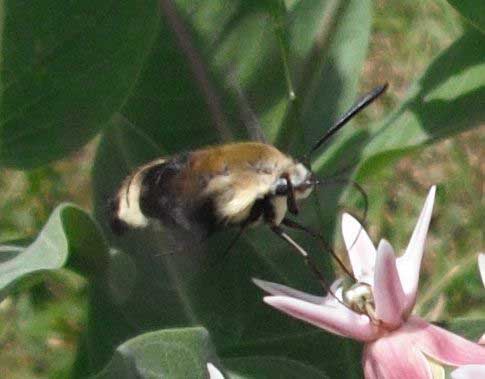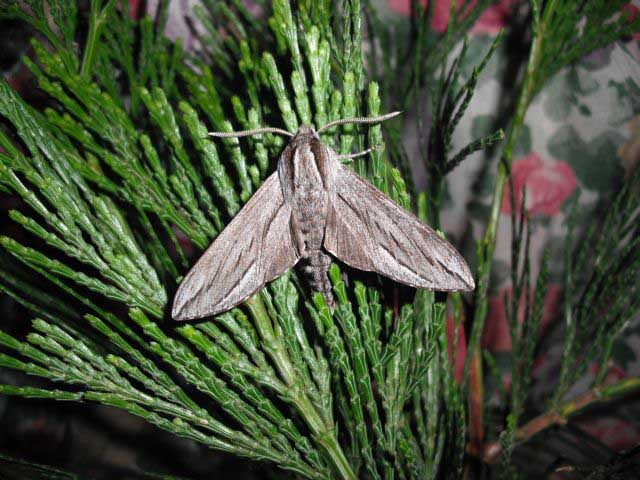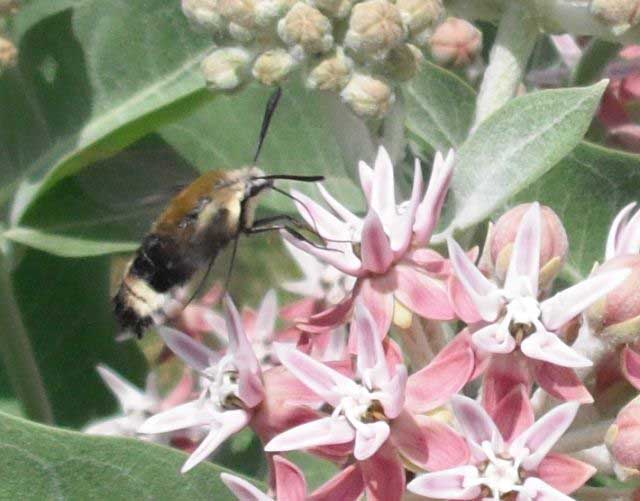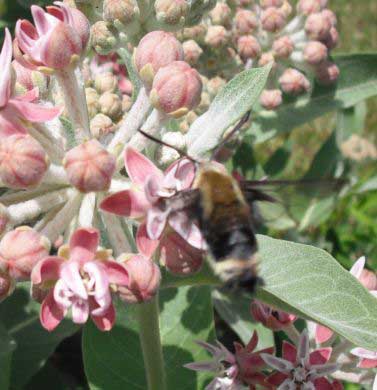Josephine County, Oregon
Sphingidae
Hemaris thetis necaring at milkweed, Wolf Creek, Josephine Co., Oregon,
June 11, 2009, courtesy of Edna Woodward.
|
|
Updated as per James P. Tuttle's The Hawk Moths of North America, June 2009 Updated as per personal communication with Edna Woodward, Wolf Creek, Josephine County; ongoing |

Hemaris thetis necaring at milkweed, Wolf Creek, Josephine Co., Oregon,
June 11, 2009, courtesy of Edna Woodward.
Edna sends the images of Hemaris diffinis (now thetis) at top and bottom of this page, and she writes, "Remember last year (2008) I reported these in June and August? Well here they are. I saw one three days ago but couldn't get a pic and it rained the last 3 days. They are thick on the milkweed."
Edna has also verified Paonias excaecata and Sphinx sequoiae. She found a sphingid larva in summer of 2008, successfully overwintered the pupa and sent an image of the adult moth which emerged around 11:30 pm on June 29.
Edna has also been seeing the Sequoia Sphinx June 24-29 and has a female laying eggs on incense cedar.
She has also been able to confirm Sphinx chersis, Sphinx perelegans, Eumorpha achemon, Smerinthus cerisyi and Hyles lineata. She reports Arctonotus (now Proserpinus) lucidus on January 16, 2010 and again on February 2, 2010 with temperature around 35F.
ON April 30, 2014, she was able to take pictures of Sphinx vashti, confirming an expected presence in Josephine County.

Sphinx sequoiae male, Wolf Creek, Josephine County, Oregon,
June 29, 2009, courtesy of Edna Woodward.
It is hoped that this checklist, with the thumbnails and notes, will help you quickly identify the moths you have encountered.
A WO" after the species name indicates that I have no confirmed reports of this species in Josephine County, but I (William Oehlke) expect that this moth is present.
Please help me develop this list with improved, documented accuracy by sending sightings (species, date, location), preferably with an image, via email to Bill Oehlke.
Please also send your sightings to BAMONA, an excellent online resource.
Sphinginae subfamily
Sphinx perelegans, Wolf Creek, August 19-20, 2009, Edna Woodward Sphinx perelegans dark form, Wolf Creek, May 18, 2010, Edna Woodward. Sphinx perelegans female, Wolf Creek, July 31, 2011, Edna Woodward.
Smerinthini Tribe:
Paonias excaecata wild female, July 29, 2011, Wolf Creek, Edna Woodward.
Smerinthus ophthalmica males, Wolf Creek, June 12, 2010, Edna Woodward.
Macroglossinae subfamilyDilophonotini Tribe:
Hemaris thetis, June 8, 11, 2009, Edna Woodward.
Philampelini Tribe:
Eumorpha achemon adult, Wolf Creek, Edna Woodward, from reared larvae from eggs.
Macroglossini Tribe:
Arctonotus lucidus, Wolf Creek, February 1, 2010, Edna Woodward. |

Hemaris thetis necaring at milkweed, Wolf Creek, Josephine Co., Oregon,
June 11, 2009, courtesy of Edna Woodward.

Hemaris thetis necaring at milkweed, Wolf Creek, Josephine Co., Oregon,
June 11, 2009, courtesy of Edna Woodward.
Enjoy some of nature's wonderments, giant silk moth cocoons. These cocoons are for sale winter and fall. Beautiful Saturniidae moths will emerge the following spring and summer. Read Actias luna rearing article. Additional online help available.
Eggs of many North American species are offered during the spring and summer. Occasionally summer Actias luna and summer Antheraea polyphemus cocoons are available. Shipping to US destinations is done from with in the US.
Use your browser "Back" button to return to the previous page.
This page is brought to you by Bill Oehlke and the WLSS. Pages are on space rented from Bizland. If you would like to become a "Patron of the Sphingidae Site", contact Bill.
Please send sightings/images to Bill. I will do my best to respond to requests for identification help.
 Show appreciation for this site by clicking on flashing butterfly to the left. The link will take you to a page with links to many insect sites. |